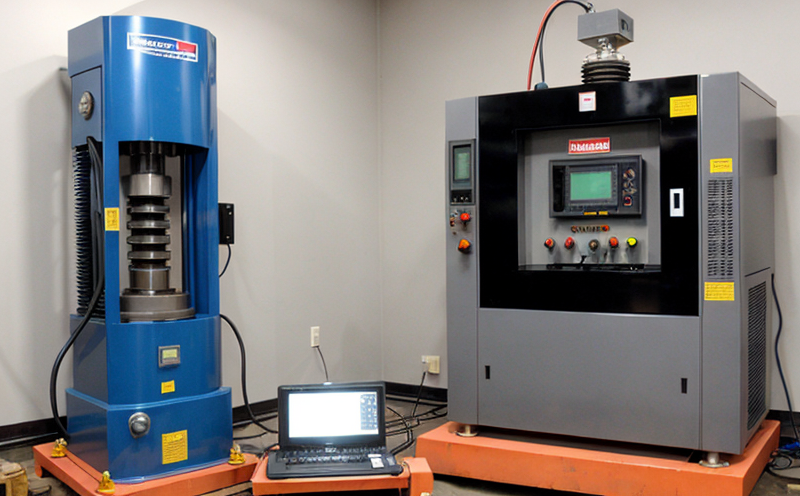SAE ARP 1870 Vibration Testing for Aircraft Equipment
SAE ARP 1870 is a recognized industry standard that specifies test methods and procedures for evaluating the durability of aircraft equipment subjected to mechanical shock and vibration. Compliance with this standard ensures that critical components within an aircraft, such as avionics, communications systems, and power supplies, can withstand the harsh operational environment during flight.
The SAE ARP 1870 protocol is designed to simulate real-world conditions encountered by aerospace equipment, ensuring reliability and performance under extreme stress. It covers various types of environmental tests including drop tests for shock testing and sine and random vibration tests for assessing the effects of varying frequencies and amplitudes on the specimen.
Before conducting SAE ARP 1870 tests, thorough preparation is necessary to ensure accurate results. This includes selecting appropriate test parameters based on the specific equipment being evaluated—such as frequency range, acceleration levels, duration, and environmental factors like temperature and humidity. Proper specimen preparation involves mounting components securely onto a vibration table or drop rig according to prescribed procedures.
The testing process itself requires precise instrumentation capable of generating controlled shocks and vibrations within specified limits. Industry-standard equipment like shakers, accelerometers, and data acquisition systems are used to measure displacement, velocity, and acceleration throughout the duration of each test run.
| Test Parameter | Description |
|---|---|
| Frequency Range | The range over which vibrations occur during flight. Typically covers from low frequencies (e.g., 10 Hz) to high frequencies (up to 5 kHz). |
| Acceleration Levels | The peak force imparted onto the test specimen, measured in g-force units. |
| Durability Time | The total elapsed time during which continuous or intermittent vibration occurs. |
| Environmental Conditions | Inclusion of temperature and humidity variations to simulate actual flight conditions. |
After completing the tests, detailed reports must be generated summarizing all measurements taken. These documents serve as evidence that the equipment meets or exceeds specified standards, providing confidence in its reliability for use aboard aircraft.
- Type of Testing: SAE ARP 1870 includes both shock and vibration testing to cover different aspects of potential failure modes.
- Purpose: To validate the resilience of aerospace components against mechanical stresses encountered during operation.
- Audience: Primarily aimed at quality managers, compliance officers, R&D engineers, and procurement professionals involved in ensuring product integrity and safety.
Why It Matters
The importance of SAE ARP 1870 cannot be overstated when considering the critical role that electronics play within aviation systems. Failures due to mechanical stress can lead to catastrophic failures, putting both personnel and aircraft at risk. By adhering strictly to this standard, manufacturers can mitigate these risks by demonstrating adherence to best practices recognized globally across the aerospace industry.
Compliance with SAE ARP 1870 helps establish credibility among buyers who rely on consistent quality standards for their decisions regarding supplier selection. It also facilitates smoother integration into larger assemblies where interoperability between different parts is crucial for overall system performance.
Industry Applications
| Aircraft Component | Purpose |
|---|---|
| Avionics | Electronic systems responsible for navigation, communication, and control functions. |
| Communications Systems | Equipment used for transmitting data between aircraft and ground stations or other aircraft. |
| Power Supplies | Devices that convert electrical power to the required voltage levels needed by various electronic devices. |
| Sensors & Actuators | Components responsible for sensing physical parameters like pressure, temperature, or position and actuating mechanical movements accordingly. |
The SAE ARP 1870 procedure ensures that all these critical components are robust enough to perform their intended functions even under adverse conditions. This makes it indispensable for any company manufacturing electronic hardware destined for use in commercial or military aircraft applications.
Use Cases and Application Examples
- Shock Testing: Evaluating the ability of an avionics box to survive drops from various heights onto different surfaces, simulating potential impact scenarios during takeoff or landing.
- Vibration Testing: Subjecting a communication module to continuous sinusoidal oscillations across its operating frequency band, checking for any signs of degradation over time.
- Environmental Stress Screening: Applying both shock and vibration simultaneously along with temperature cycling to identify latent defects early in the manufacturing process.
| Use Case | Description |
|---|---|
| Shock Testing | Evaluating the durability of a power supply under simulated drop impacts from varying altitudes and angles. |
| Vibration Testing | Assessing an onboard navigation system’s performance while subjected to synthetic air turbulence conditions created in a laboratory setting. |
| Environmental Stress Screening | Checking multiple subsystems inside a complex assembly for integrity by exposing them to rapid changes in environmental factors like heat and cold, humidity, and vibration. |
These tests provide valuable insights into how well each component will hold up during actual flight operations, helping manufacturers make informed decisions about design improvements or material substitutions where needed.





